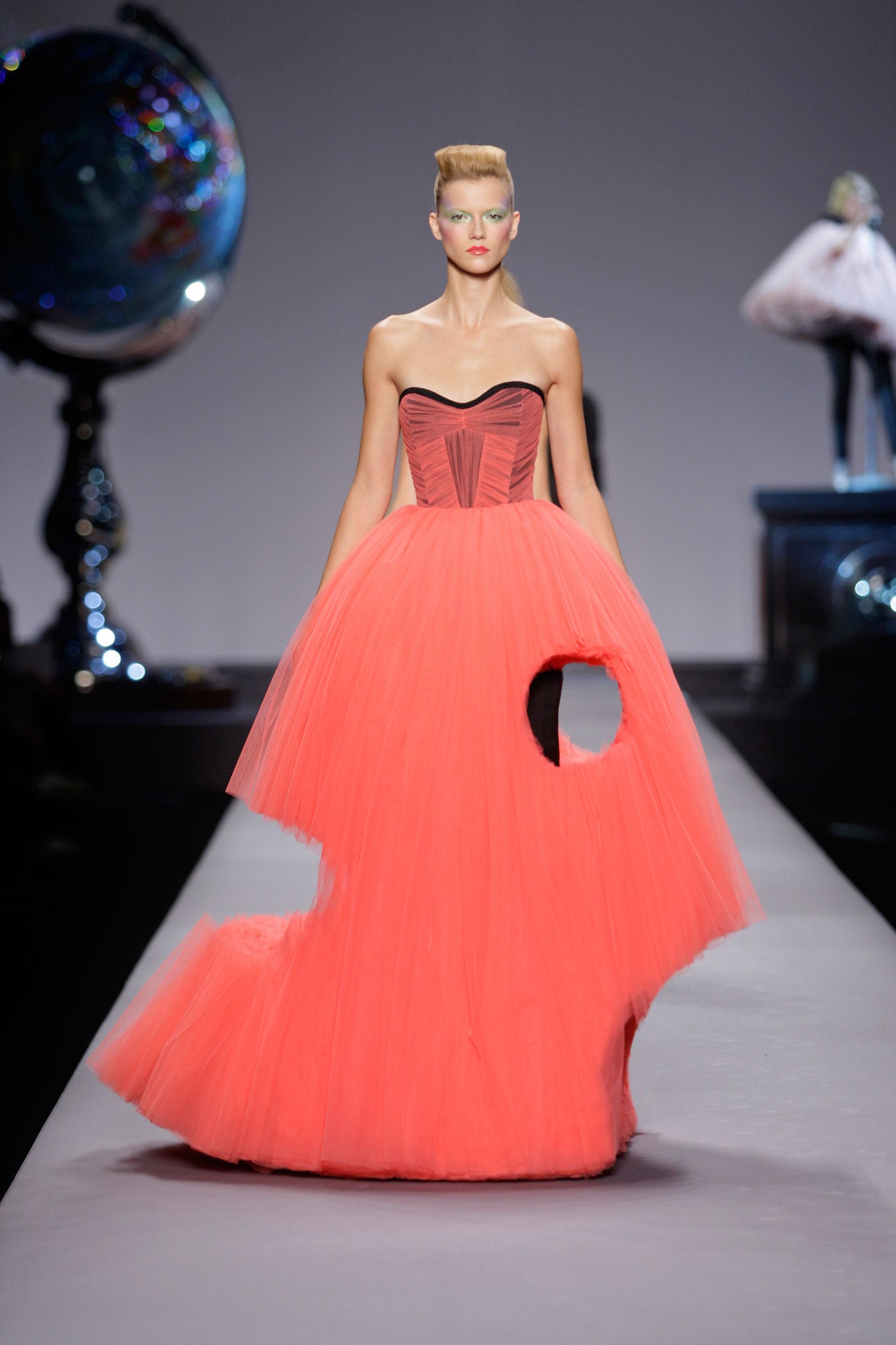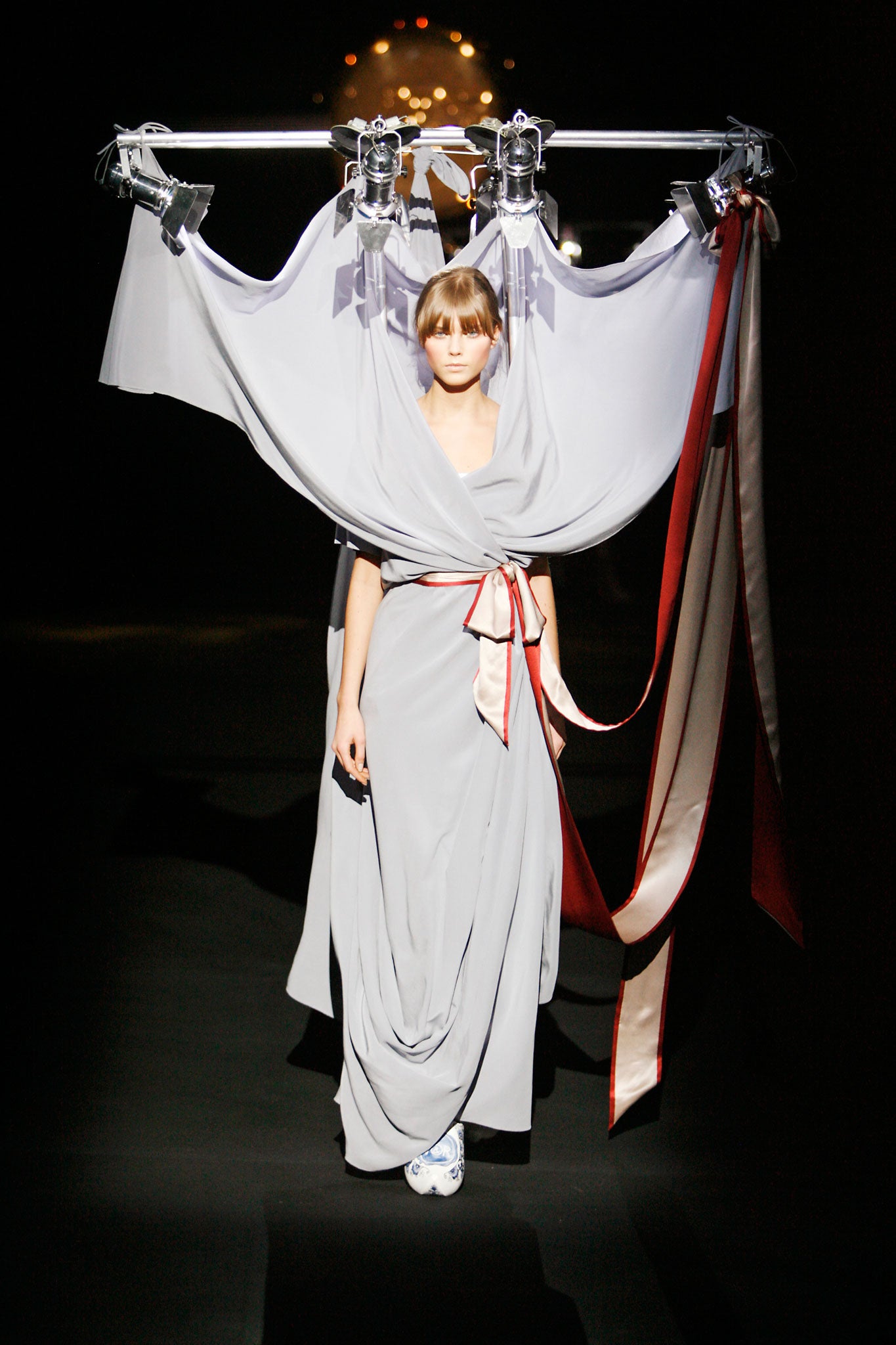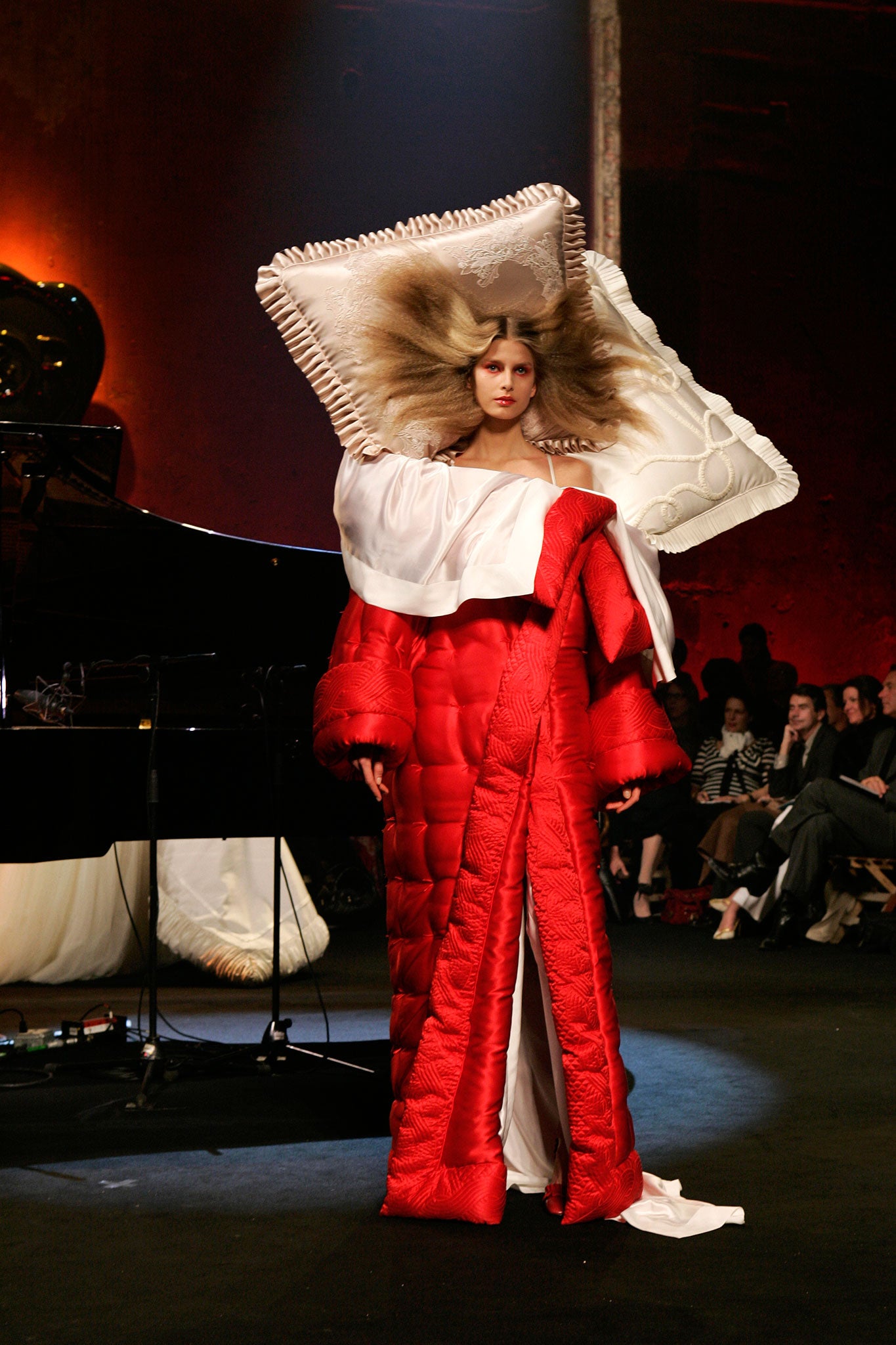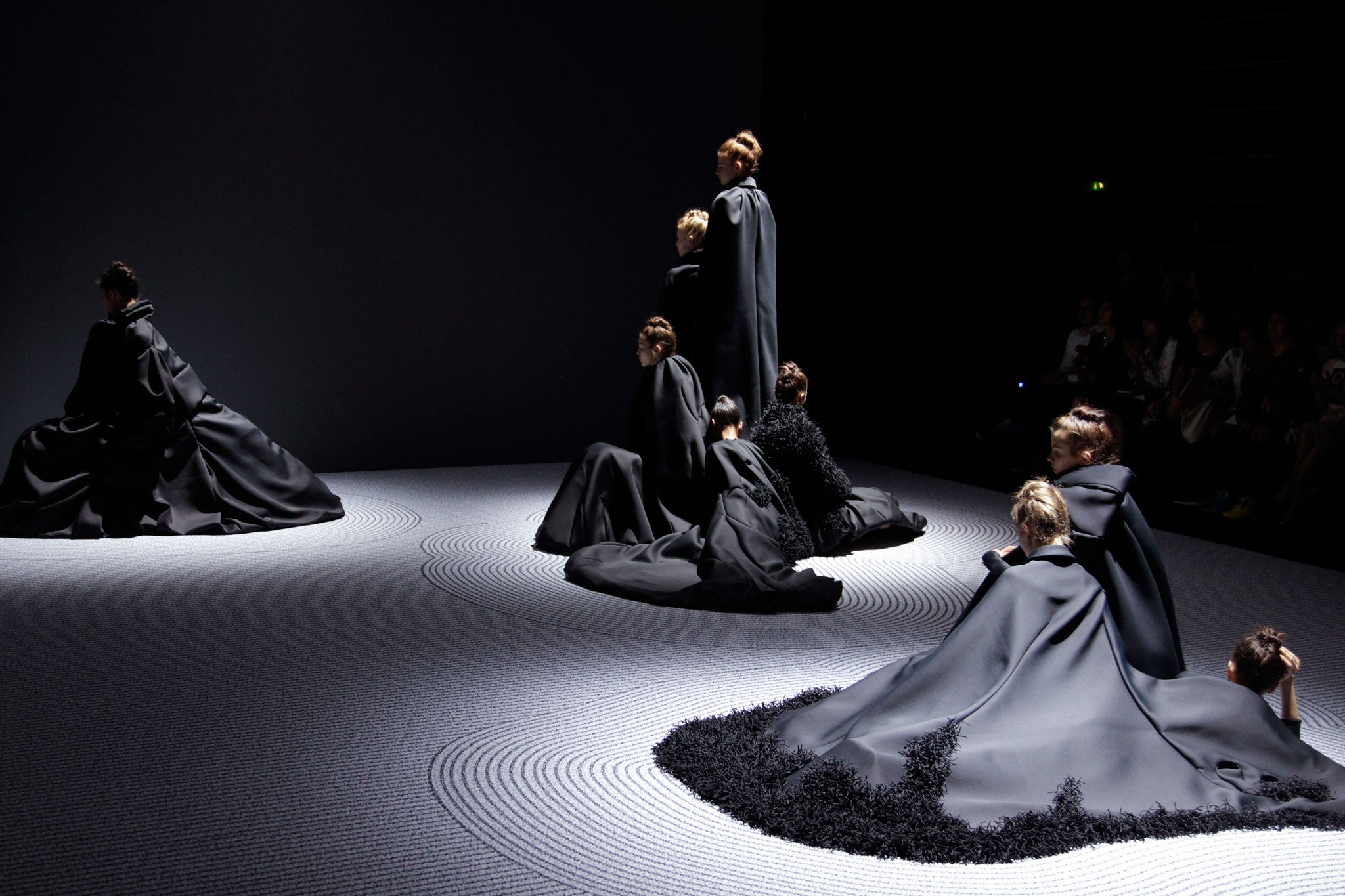Dutch courage: Meet Viktor and Rolf, the off-the-wall designers behind fashion's weirdest creations
Bedsheets and broomsticks, atomic bombs, Zen gardens, Gruyère cheese and scaffolding. Not your usual inspiration for fancy frocks. Yet the couture world of Viktor & Rolf has been enthralling fashion for 20 years. Alexander Fury meets the Dutch duo
The day after their latest haute couture show, the designers Viktor Horsting and Rolf Snoeren, of the Viktor & Rolf label, want to meet in the gilded enclaves of the Hôtel Meurice in Paris. That in itself is not unusual for designers, and certainly not for couture designers. Lavished with gilt in the grandiose style of Louis Philippe – 18th-century extravagance with a 19th-century heaviness of hand – it seems a natural enclave for purveyors of the most expensive dresses in the world. Haute couture's native habitat.
But Viktor and Rolf – the designers and the label – have always confounded fashion expectations. For spring 1996, they went on strike, clutching placards rather than presenting clothes. The same year, they launched Le Parfum, a 'virtual' scent. The scent was actually water, packaged in a bottle that was impossible to open. Another soon-to-go-stratospheric Dutch duo, Inez van Lamsweerde and Vinoodh Matadin, photographed a mock campaign for the fragrance. They've shown garments on dolls, as shadows of other garments, or made out of fabric emblazoned with other fashion houses' names (because it was specially-woven for said designers).
Those were all, ostensibly, couture collections, presented from 1993 to 2000. Many were shown guerrilla-style off-schedule. Their 1998 break-out show was inspired by the Millennium – the idea that it would either mark the apocalypse, or one hell of a party. Hence, outfits combined Pierrot/Harlequins, balloons or party streamers with silhouettes inflated at the neck, like a mushroom cloud. They dubbed it 'Atomic Bomb'. And Viktor & Rolf, fittingly, exploded.
Horsting and Snoeren took a break from the couture schedule during the past 13 years, focusing instead on that which they first wilfully ignored: building a business. Their Flowerbomb perfume, again with a campaign photographed by Inez and Vinoodh – although this time with a functional bottle (and actual scent) – launched in 2004 to dizzying success. Menswear came in 2003. They now produce six collections a year, excluding their haute couture which, Rolf states, "of course" they will now continue. Five years ago, a majority stake in their company was purchased by Only The Brave, owned by Diesel's Renzo Rosso.

Commercial acumen hasn't stopped Viktor and Rolf's fashion hijinks. In 2005, they presented a collection of luxe bedsheets crafted into evening dresses. In 2010, models wore tulle debutante dresses the designers had hacked holes into with chainsaws, rather than the more usual dressmaking shears.
And, for autumn/winter 2007, in one of their most extreme collections, they kitted each model out with their own lighting rig and sound system, clothes draped over the scaffolding. Couple those ungainly ensembles with high-heeled clogs and the phrase 'Dutch courage' is given a different meaning. "When the applause came, Viktor and Rolf may not have realised it was all for the models' heroic endurance, rather than for them," sniped Sarah Mower, reviewing for Style.com.
That's the bizarre frockery of Viktor & Rolf, in a nutshell. It's loud, showy, provocative. Like that 1998 couture collection, their best shows are aesthetic atomic bombs. They resonate loudly in the public consciousness. Horsting and Snoeren, however, unlike their clothing, are quiet. When we meet in the Meurice, f they seem to retreat into themselves, swamped by their florid surroundings.
Listening back to our conversation, I do more than my fair share of talking. Occasionally, their answers take on a Warholian cadence. When I suggest a link, perhaps subconscious, between the uniform theme of their menswear and their return to haute couture – hand-crafted clothing, the anti-uniform, each true one-offs – there's a pause. "Wow. I never thought about that," remarks Rolf, flatly. And on to the next question. It's a well-rehearsed routine.

The Warholian comparison feels entirely appropriate: what Viktor and Rolf have done for high fashion is what Andy Warhol did for high art. They made it punchy, poppy, easy to understand. You don't have to think about it too hard. They invite introspection.
Their reticence to open up makes me wonder, in a paranoid way, if it's something I've said. I've said a lot. I've taken them to task for over-egging themes, overworking decorative motifs, for pushing their conceptual shtick into slapstick: life-sized dolls, comedy drawbridge sounds for a 'fashion crusade', models dressed as statues with grey-painted faces. Really?
If the criticism was a motivating factor, it's easy to understand why Horsting and Snoeren take it personally – even more personally, in fact, than fellow designers. Like Warhol's work, Viktor and Rolf themselves have become part of their product. The designers tap-danced at their spring 2001 show, modelled their first menswear collection in 2003, and have ended up on the catwalk dressing and undressing models on three separate occasions. "Each of these performances had a different reason," says Rolf. "They all needed someone to do something that's not normally done during fashion shows. So that... made it apparent that it had to be someone who is not a model. It's a logical consequence that it would be us."

They were also centre-stage this July, at their winter haute couture show: the designers began by meditating, silently, at the centre of a fake Japanese gravel garden. The show was already 40 minutes late. The howling, catcalling photographers somewhat disrupted the Zen atmosphere Viktor and Rolf were going for. As the models curled, crouched and stretched into yoga poses, the designers themselves were on hand to tweak every voluminous all-black ensemble, each tailored to exactly fit the models' twisted bodies like slip-covers.
"We wanted to do something that would reflect our current state of mind," says Rolf of the collection's inspiration. "After 20 years of being so ambitious, running around and running after things... there comes a moment when you have to just enjoy things," reasons Viktor. "Being in the present. So that was the motivation behind it. That's how we came up with the idea to have these 20 girls, one for each year." That's Rolf, again. They talk like a table-tennis match. Indeed, they have compared their creative process to just that. "It's two people as one. It's like ping-pong. You have one vocabulary," Rolf tells me.
Horsting and Snoeren were both born in 1969 in the Netherlands, only meeting 19 years later when studying fashion at the Arnhem Academy of Art and Design. "I went to school thinking that I would become a fashion illustrator," says Viktor. "And then I met him." "It's all my fault," deadpans Rolf. They make a great double-act. Which is what drew them together in the first place. "We noticed we shared a vision," is Viktor's simple statement. Rolf, naturally, picks up the thread. "When we started, especially the first years, we thought it was great, but we didn't think 'Oh, we are a brand' or 'This is where this is going'. We just enjoyed working together, we did share an ambition. Creating something. It was very much a creative ambition."
That would make many scoff. After all, fashion isn't about pure creativity, but about marrying said creativity with commerce to make lots of money through lots of expensive clothes. Viktor and Rolf started with haute couture, the most expensive frocks of them all – with prices starting in the hefty five figures and sometimes rising to six.

However, given how tiny the market is for six-figure hand-crafted frocks, never mind ones that make you look like you have cranial gout, it's the industry's high-profile, high-price loss-leader. Viktor & Rolf scraped by on press acclaim, museum sales and government subsidies for their first seven years, before launching their ready-to-wear range and reaping the commercial rewards. "We experimented a lot in those seven years... to focus what we want to do," says Viktor. Wearability, apparently wasn't, and isn't, the point. "The ultimate aim is expressing our ideas in the best way; to have people wearing it is a great bonus."
The difference between today and the label's starting point in 1993 – or even midway between the two in 2003 – is that lots and lots of people can, and have, worn Viktor & Rolf. In 2006, the pair collaborated with H&M, at that point only the third of the mass-retailers designer collaborations. The 2008 deal with Diesel geared them up to create pre-collections and catwalk shows that, more than ever before, are geared to mass-appeal. Their winter womenswear was a riff on white shirts and shredded jeans, the distressed detailing synched with the Metropolitan Museum's punk exhibition. It was a commercial, rather than creative exercise. Kind of like those mass-appeal, mass-production Warhol-commission portraits of wealthy socialites.
A decade ago, Viktor and Rolf talked about the end of a certain chapter. It was the eve of the release of Flowerbomb – and publicising fragrance is the reason houses today continue creating the high-profile but not-much-bought haute couture. You wonder if this return to the haute couture schedule – and, frankly, to form, as said winter collection is one of their best – marks another chapter. One where creativity and commerce can make as good a pairing as, say, Viktor and Rolf themselves.
Join our commenting forum
Join thought-provoking conversations, follow other Independent readers and see their replies
0Comments